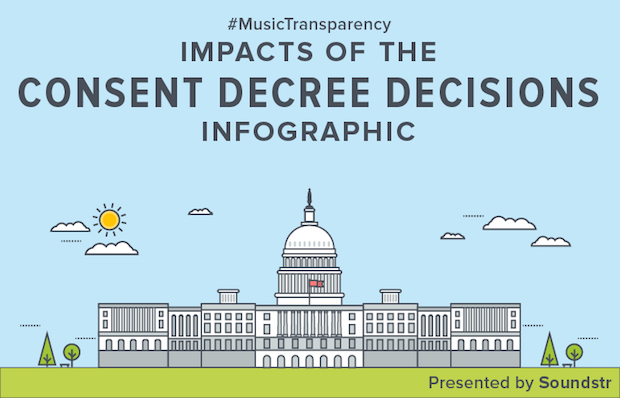 Image via soundstr.com
Image via soundstr.com
This infographic originally appeared on Soundstr.
If you follow the news in the music industry, you might have been hearing about the consent decree lately. Even if you aren't exactly sure what it means, you may have been able to gather that the revisions made on the consent decree will greatly impact songwriters. There are some songwriters who are starting to sweat, and you may be as well.
If you're wondering what exactly the consent decree is... well, there's a lot to it. Its purpose is essentially to regulate how ASCAP and BMI operate and prevent the development of a monopoly in the industry. ASCAP and BMI are nonprofit companies, and the consent decree binds them to this agreement. However, there are other for-profit companies, SESAC and GMR, that aren't bound.
It's not unusual for the Department of Justice to amend the consent decree every once in a while. With this revision, there are two major points that songwriters need to be aware of. The no partial withdrawal and the 100 percent licensing revision are both very important changes that could largely impact music licensing in the future.
To keep it short, the no partial withdrawal means that publishers have to either be "all in" or "all out" with performing rights organizations (ASCAP, BMI, SESAC, and GMR). Publishers have to use these PROs to collect from all mediums or not. Publishers weren't too happy about this revision since there are some companies that would rather establish license deals with digital service providers like Spotify and Pandora, but it's becoming a "one or the other" situation.
What does that mean for songwriters? The one-or-the-other aspect of the revision means that publishers will have more work to do on the collection side of things, but it may mean that songwriters will get paid more.
The 100 percent licensing revision would give the songwriter, and anyone who has any songwriting credits, the right to license the entire song, even if they only have a sliver of a percentage. This decision could lead to some sticky situations, as we currently are operating in a fractional licensing industry, where songwriters are only able to license their percentage of the song.
This infographic from Soundstr visually explains all the information you need to know about these changes. If you're interested to read more on this topic, check out Soundstr's blog post about the revisions.








